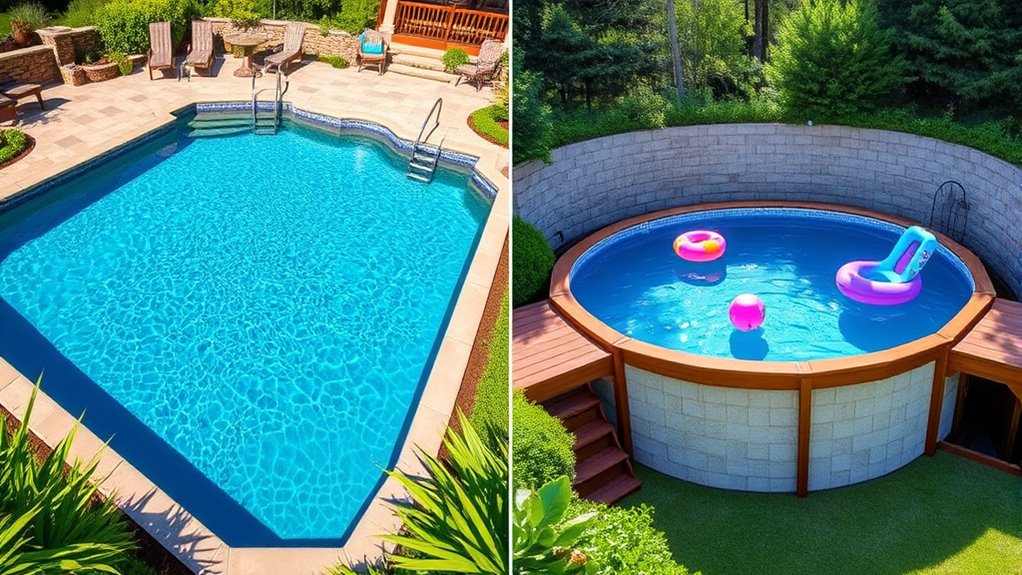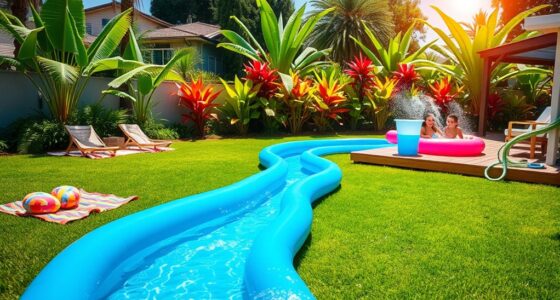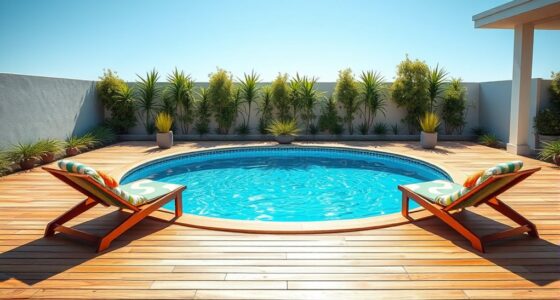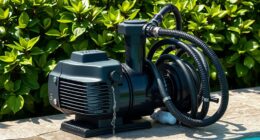When choosing between inground and above-ground pools, consider installation time, cost, and durability. Inground pools take weeks to install and last 20 to 50 years but cost around $31,000. Above-ground pools are quick to set up and cost about $8,300, lasting only 10 to 15 years. Regarding aesthetics, inground pools offer more customization options, while above-ground pools are easier to disassemble. Explore these differences further to find the best fit for your backyard oasis.
Key Takeaways
- Inground pools are a permanent installation, while above-ground pools are semi-permanent and can be disassembled.
- The average cost of a small inground pool is approximately $31,000, compared to around $8,300 for a standard above-ground pool.
- Inground pools typically last 20 to 50 years, whereas above-ground pools have a lifespan of only 10 to 15 years.
- Inground pools offer extensive customization options, while above-ground pools can be enhanced with decks but have limited design flexibility.
- Safety features differ, with above-ground pools having higher walls that reduce falls, while inground pools require careful safety design around decking.
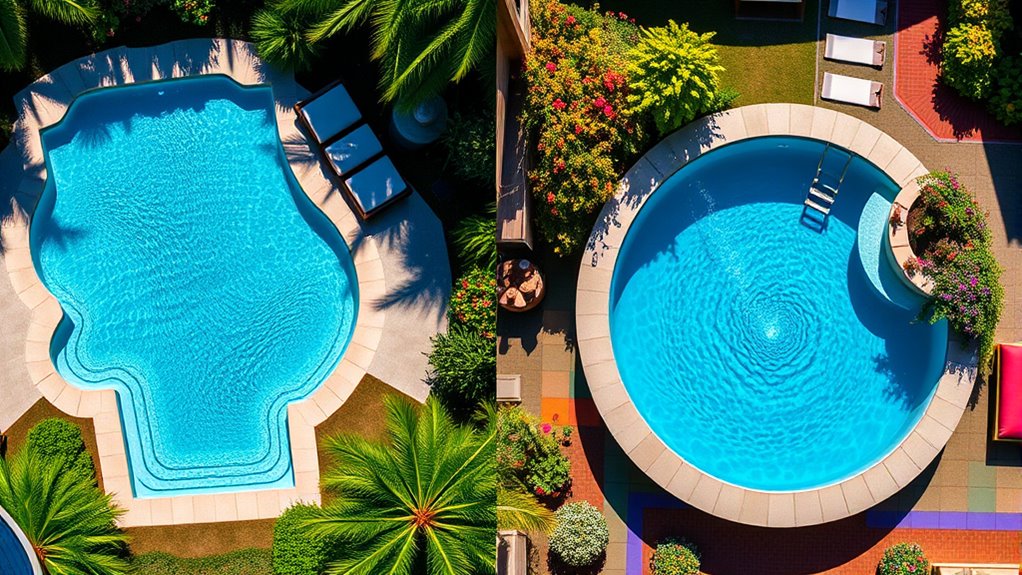
When deciding between inground and above-ground pools, it’s crucial to weigh the pros and cons of each option. The installation process plays a significant role in your choice. Inground pools can take several weeks due to extensive excavation and site preparation, while above-ground pools can be ready in just one to three days with minimal ground leveling.
If you’re looking for a permanent addition to your yard, an inground pool fits the bill, but above-ground pools offer a semi-permanent solution that can be disassembled if needed.
Cost is another essential factor. Installing an inground pool typically requires a hefty investment, averaging around $31,000 for a small pool. On the flip side, above-ground pools are more budget-friendly, usually costing around $8,300 for a standard size.
You’ll find that above-ground pools are generally cheaper to maintain over the years, while inground pools might drain your wallet with higher long-term maintenance and repair costs. However, if you’re thinking about property value, inground pools can enhance your home’s appeal and potentially offset those initial costs.
Durability and lifespan also differentiate these two options. Inground pools can last anywhere from 20 to 50 years, thanks to their robust construction. Above-ground pools, however, typically last only 10 to 15 years, which might influence your decision if you’re looking for longevity.
While inground pools require more complex maintenance, above-ground pools are easier to repair and maintain.
Aesthetics and customization are important too. Inground pools offer limitless options in shape, size, and features, blending seamlessly into your landscape. You can add waterfalls, spas, and other intricate designs to create a luxurious look.
Above-ground pools can be visually enhanced with decks and siding, but they often can’t compete with the elegance of an inground pool.
Safety is a critical consideration. Above-ground pools usually have higher sides, which can reduce accidental falls, while ladders for entrance and exit can be safer for some users. Inground pools require careful design to guarantee safety around the decking.
Regardless of your choice, supervision is essential to guarantee users are safe.
Ultimately, your decision should reflect your needs, budget, and aesthetic preferences. Whether you prioritize cost, durability, or design flexibility, understanding these differences can guide you in making the right choice for your backyard oasis.
Frequently Asked Questions
What Is the Average Lifespan of an Inground Pool?
The average lifespan of an inground pool varies depending on the type.
Concrete pools can last over 50 years with proper care, while fiberglass pools typically last more than 30 years.
Vinyl pools, on the other hand, usually need liner replacements every 6 to 12 years.
Regular maintenance greatly impacts longevity, so keeping up with cleaning, inspections, and repairs can help you enjoy your pool for many years to come.
Can I Install an Above Ground Pool Myself?
Ever thought about diving into DIY? You can definitely install an above ground pool yourself!
With some physical strength, basic tools, and a bit of assembly know-how, you’re well on your way. Just make sure the ground is level and firm for stability.
While it can be challenging, especially aligning walls and managing seams, the satisfaction of your own pool is worth it. Plus, you’ll save on installation costs!
Are Inground Pools More Energy-Efficient Than Above Ground Pools?
Yes, inground pools are generally more energy-efficient than above ground pools.
Their below-ground installation provides natural insulation, helping to retain heat effectively. While you might face higher initial costs, the long-term savings on heating can be significant.
Above ground pools, with their design, struggle to maintain consistent water temperatures, which can lead to increased energy use.
What Maintenance Is Required for Each Pool Type?
You’d think maintaining a pool is all sunshine and relaxation, right? Well, think again!
For inground pools, you’ll need daily skimming, regular vacuuming, and frequent water testing. Don’t forget to brush the walls and monitor your equipment.
Above-ground pools are simpler but still require daily skimming and occasional vacuuming. You’ll test the water chemistry, too, just not as often.
Either way, pool maintenance isn’t just a splash; it’s a commitment!
How Do I Winterize My Above Ground Pool?
To winterize your above ground pool, start by balancing the water chemistry and performing a shock treatment.
Clean the pool by skimming debris and vacuuming the floor.
Lower the water level below the return lines, then disconnect and drain all equipment.
Apply winterizing chemicals and run the pump for 24 hours to circulate them.
Finally, cover the pool with a winter cover to keep it safe from debris and algae growth.
Conclusion
When deciding between inground and above ground pools, it really comes down to your preferences, budget, and space. Inground pools offer a luxurious feel and endless customization, while above ground pools are budget-friendly and easier to set up—almost like the convenience of a microwave dinner compared to a gourmet meal! No matter your choice, both can turn your backyard into a summer oasis. Immerse yourself and choose the one that fits your lifestyle best!
